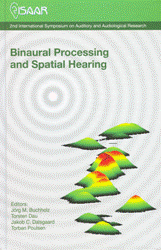Test person operated 2-Alternative Forced Choice Audiometry compared to traditional audiometry
Abstract
A new constructed user operated audiometry system was evaluated and compared to traditional audiometry. User operated audiometry was based on the 2 Alternative Forced Choice (2AFC) paradigm in combination with the method of maximum-likelihood (MML), which was used dertemine user- operated hearing thresholds after tting of the most probable psychometric function. Combination of the 2AFC paradigm and the MML gave reliable hearing thresholds. User operated audiometry was validated by comparison to traditional audiometry. 30 persons (60 ears) performed traditional audiometry as well as user-operated 2AFC-audiometry. Test subjects were normal and moderately hearing impaired. User operated audiometry was reliable compared to traditional audiometry. User-operated audiometry thresholds were 1-2 dB lower compared to traditional audiometry. Standard deviations between the two test methods were below 4.5 dB for frequencies from (250-4000 Hz) and up to 6.7 dB for frequencies above 4000 Hz. Test-retest studies of user-operated audiometry were comparable to traditional audiometry. User-operated 2AFC audiometry can be a reliable alternative to traditional audiometry especially under certain circumstances, where it can be dif cult to get skilled technical assistance to conduct the audiometry.
References
Dobie, R. A. (1983). “Reliability and validity of industrial audiometry: implications for hearing conservation program design,” Laryngoscope 93, 906-927.
Gatehouse, S., and Davis, A. (1992). “Clinical pure-tone versus three-interval forced- choice thresholds: effects of hearing level and age,” Audiology 31, 31-44.
Green, D. M. (1993). “A maximum-likelihood method for estimating thresholds in a yes-no task,” J. Acoust. Soc. Am. 93, 2096-2105.
Gu, X., Green, D. M. (1994). “Further studies of a maximum-likelihood yes-no procedure,” J. Acoust. Soc. Am. 96, 93-101.
International Organization for Standardization (1989). “Acoustics - Audiometric test methods - Part 1: Basic pure tone air and bone conduction threshold audiometry,” ISO8253-1 (Geneva: ISO). Including a draft version of the revision of this standard.
International Organization for Standardization (2004). “Acoustics - Reference zero for the calibration of audiometric equipment - Part 8: Reference equivalent threshold sound pressure levels for pure tones and circumaural earphones,” ISO 389-8 (Geneva: ISO).
Leek, M. R., Dubno, J. R., He, N., and Ahlstrom, J. B. (2000). “Experience with a yes-no single-interval maximum-likelihood procedure,” J. Acoust. Soc. Am. 107, 2674-2684.
Leek, M. R., Hanna, T. E., and Marshall, L. (1992). “Estimation of psychometric functions from adaptive tracking procedures,” Percept Psychophys 51, 247-256.
Levitt, H. (1971). “Transformed up-down methods in psychoacoustics,” J. Acoust. Soc. Am. 49, Suppl.
Marshall, L. (1991). “Decision criteria for pure-tone detection used by two age groups of normal-hearing and hearing-impaired listeners,” J. Gerontol. 46, 67-70.
Marshall, L., Hanna, T. E., and Wilson, R. H. (1996). “Effect of step size on clinical and adaptive 2IFC procedures in quiet and in a noise background,” J Speech Hear Res 39, 687-696.
Marshall, L., and Jesteadt, W. (1986). “Comparison of pure-tone audibility thresholds obtained with audiological and two-interval forced-choice procedures,” J Speech Hear Res 29, 82-91.
Marvit, P., Florentine, M., and Buus, S. (2003). “A comparison of psychophysical procedures for level-discrimination thresholds,” J. Acoust. Soc. Am. 113, 3348- 3361.
O’Regan, J. K., and Humbert, R. (1989). “Estimating psychometric functions in forced- choice situations: signi cant biases found in threshold and slope estimations when small samples are used,” Percept Psychophys 46, 434-442.
Riedner, E. D. (1980). “Collapsing ears and the use of circumaural ear cushions at 3000 Hz,” Ear Hear 1, 117-118.
Shaw, E. A. (1966). “Earcanal pressure generated by circumaural and supraaural earphones 2,” J. Acoust. Soc. Am. 39, 471-479.
Watson, C. S., Franks, J. R., and Hood, D. C. (1972). “Detection of Tones in Absence of External Masking Noise .1. Effects of Signal Intensity and Signal Frequency,” J. Acoust. Soc. Am. 52, 633-643.
Additional Files
Published
How to Cite
Issue
Section
License
Authors who publish with this journal agree to the following terms:
a. Authors retain copyright* and grant the journal right of first publication with the work simultaneously licensed under a Creative Commons Attribution License that allows others to share the work with an acknowledgement of the work's authorship and initial publication in this journal.
b. Authors are able to enter into separate, additional contractual arrangements for the non-exclusive distribution of the journal's published version of the work (e.g., post it to an institutional repository or publish it in a book), with an acknowledgement of its initial publication in this journal.
c. Authors are permitted and encouraged to post their work online (e.g., in institutional repositories or on their website) prior to and during the submission process, as it can lead to productive exchanges, as well as earlier and greater citation of published work (See The Effect of Open Access).
*From the 2017 issue onward. The Danavox Jubilee Foundation owns the copyright of all articles published in the 1969-2015 issues. However, authors are still allowed to share the work with an acknowledgement of the work's authorship and initial publication in this journal.


